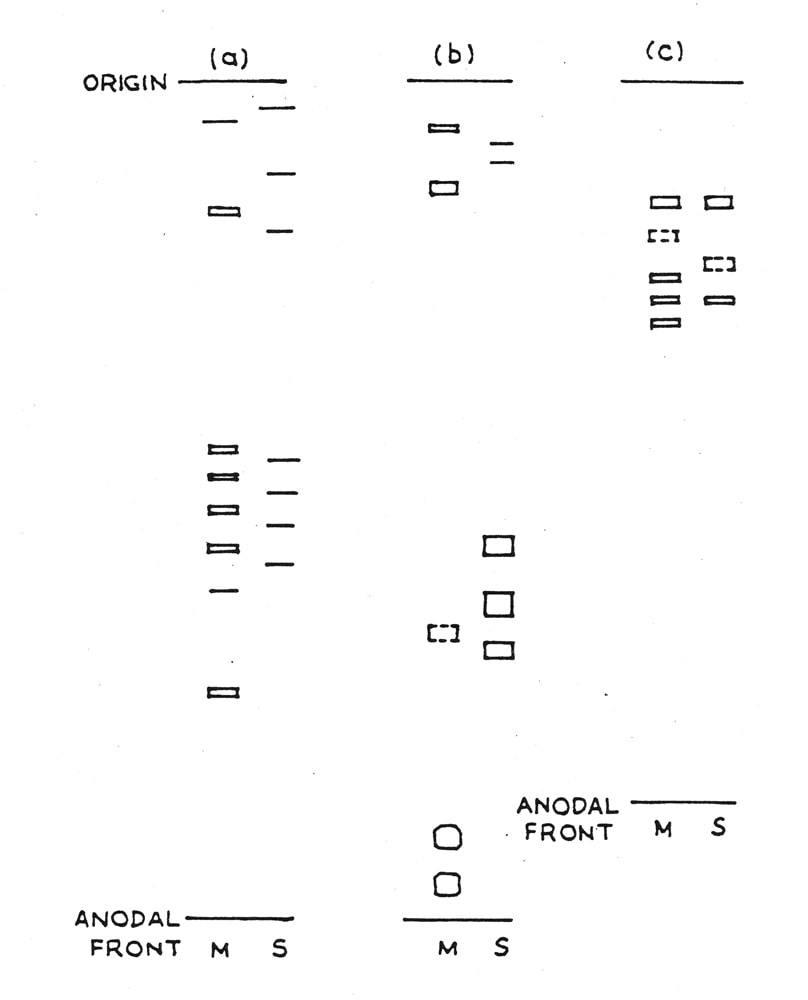Cucurbit Genetics Cooperative Report 12:18-19 (article 8) 1989
V.S. Sujatha and V.S. Seshadri
Division of Vegetable Crops, Indian Agricultural Research Institute, New Delhi 110012 India
The genus Cucumis contains 30 species of which only two species, C. sativus (cucumber) and C. melo (muskmelon), are extensively cultivated. While C. melo has chromosome number of x=12, and C. sativus has x=7, the attempts to produce interspecific hybrids between the two have not succeeded (2,3). An isozymic analysis was designed to compare the two taxa and determine whether justification exists to classify them as a single genus. Taxa were compared using peroxidase ( PRX), glutamate oxaloacetate transaminase (GOT) and esterase (EST).
Methods. Polyacrylamide gel electrophoresis was performed using varietal slab gels (ADCO, India) at 5°C under 40 MV in the following manner. Peroxidase (PRX) was sampled from the root and hypocotyl region of 4 to 5 week-old seedlings. Gels consisted of 7% acrylamide, and electrophoresis was carried out using a Tris-chloride gel buffer (pH 8.3). Gels were stained according to Conklin and Smith (1). Glutamate oxaloacetate transaminase was sampled from 3 to 4 day-old seedling, and electrophoresis was performed using 9.5% gels. Gel and electrode buffers were the same as those used for peroxidase, and staining procedures were those of Shaw and Koen (6). Esterase was sampled from 3 to 4 day old seedling and extracts electrophoresed on a 7.0% gel. Gel and electrode buffers were the same as above, and staining was performed according to Shaw and Koen (6).
Results. In the peroxidase system, C. sativus was lacking in the fastest moving PRX which was present in all the Cucumis species (x=12; data not shown). The allozymes of C. sativus were observed at PRX2, PRX3 and PRX4, corresponding to the three loci of C. melo. However, allozymes of C. sativus were not similar in mobility to those of C. melon (Fig.1).
The two taxa shared a common band at GOT4. This allozyme was common to the 13 Cucumis species studied and absent in the other general in the Cucurbitaceae like Citrullus, Luffa, Momordica, Praecitrullus, Lagenaria (data not presented). The allozyme at GOT1 present in C. melo was absent in C. sativus. The allozyme at GOT2 of C. sativus had identical mobility with the hybrid isozyme at GOT2 in C. melo. However, since the banding pattern at GOT2 in C. melo was identified to be a hybrid type, the allozyme at GOT2 of C. sativus was treated as having a different subunit constitution than that of the hybrid allozyme of C. melo. The allozymes at GOT3 also differed in mobility. There were no similarities between the two taxa in esterase zymograms.
Data suggest that there is little similarity between C. melo and C. sativus for the 3 enzymes studied. However, isozyme constitution at GOT4 in both species was characteristic of the genus Cucumis, and justifies their classification under the genus Cucumis. This conclusion contrasts to that of Pangalo (4), who suggested that the two Cucumis species should be elevated to generic status because of their wide variability, non-crossability, and chromosome number differences. Also, Ramachandran and Seshadri (5) consider C. sativus cytogenetically very different from C. melo. Our data (common band at GOT4) of C. melo and C. sativus lends support to the proposition that these widely divergent taxa remain under one genus.
Fig. 1. Comparison of zymograms of C. sativus (S) and C. melo (M) for peroxidase (a), esterase (b), and glutamate oxaloacetate transaminase (c).

Literature Cited
- Conklin, M.E. and H.H. Smith. 1971. Peroxidase isozymes. A measure of molecular variation in ten species of Datura. Amer. J. Botany 58: 688-696.
- Dane, F., D.W. Denna and T. Tsuchiya. 1980. Evolutionary studies of wild species in the genus Cucumis. Zeits. Pfanzenzucht. 85: 89-109.
- Deakin, J.R., G.W. Bohn and T.W. Whitaker. 1971. Interspecific hybridization in Cucumis. Econ. Bot. 25: 105-211.
- Pangalo, K.I. 1950. (Melons and independent genus Melo Adans). Botanichesky Zhurnal 35: 571-80.
- Ramachandran, C. and V.S. Seshadri. 1986. Cytological analysis of the genome of cucumber (Cucumis sativus L.) and muskmelon (Cucumis melo L.). Z. Pflanzenzucht. 96: 25-38.
- Shaw, C.R. and A.L. Koen. 1968. Starch gel zone electrophoresis. In: L. Smith (Ed.), Chromatographic and electrophoretic techniques. Vol. 2. John Wiley, New York.